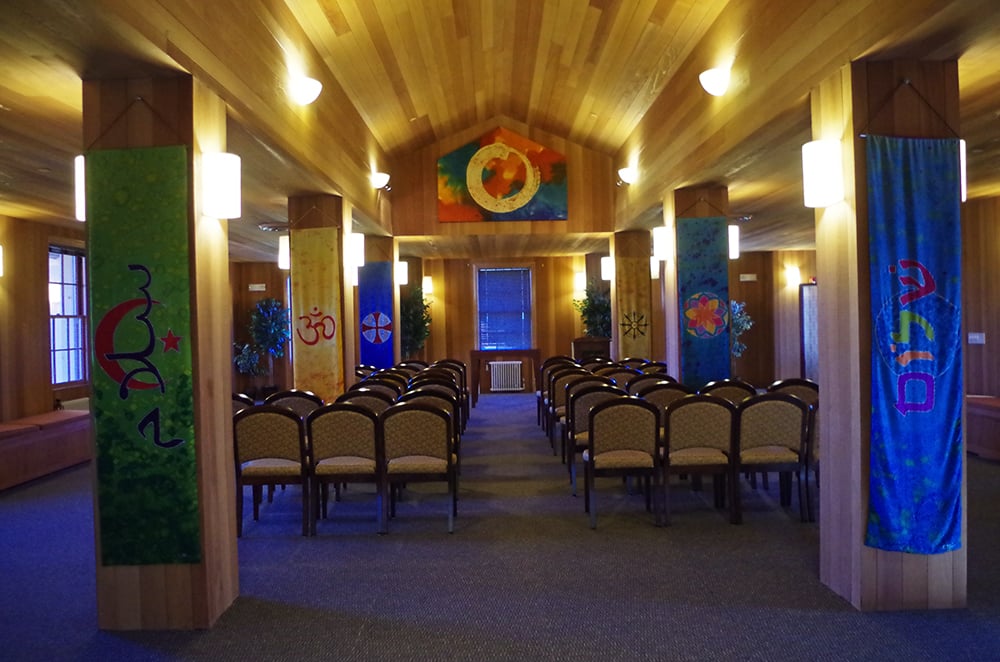Wood paneling decorates the Center for Inter-Religious Community, Learning and Experiences (CIRCLE)’s sanctuary room, which is flooded with natural sunlight spilling into the room through the sanctuary’s wide windows. While the room has an air of spirituality that is both comforting and respectful, what truly marks the space as a home for inter-religious community, learning and experiences, however, are the banners hanging on the Sanctuary’s six pillars representing six popular world religions: Islam, Hinduism, Christianity, Buddhism, Baha’i and Judaism.

(SAM GIRVIN/The Stanford Daily)
CIRCLE, which opened in 2007, serves as a home and a sanctuary for 35 Stanford Associated Religions (SAR) groups. Students can relax in the spacious lounge, study in CIRCLE’s religious library and even cook in CIRCLE’s kitchen, all of which are located on the third floor of Old Union. CIRCLE also offers gender-specific wudu stations, where both Muslim men and women can wash their feet prior to entering the sanctuary for prayer.
“It is a place where people from many different traditions can literally rub elbows and move around in the same space with each other,” said Dean of Religious Life Scotty McLennan. He noted that CIRCLE hosts both multi-faith activities as well as activities specific to certain religious traditions.
Nausheen Mahmood ‘14, vice president of the Islamic Society of Stanford University, said she uses the CIRCLE often, mostly for its private office where Muslim students can go in and pray throughout the day and the Sanctuary where they hold Friday prayer.
“For many years, the CIRCLE has been the home base for the Muslim community,” Mahmood said.
Although CIRCLE aims to provide an inter-religious community, the Markaz Resource Center opened on the second floor of the Nitery in September following advocacy by the Muslim student community. The Markaz consists of two rooms — a lounge space and a computer room — and marks the culmination of a 10-year project.
Students behind the development of the Markaz, including Muslim Student Awareness Network president Hana Al-Henaid ‘14 and vice president Sayeh Fattahi ‘14, had written a series of proposals emphasizing the need for a designated space for Stanford’s Muslim student population to engage in discussion about issues surrounding their culture and identity.
The distinction between CIRCLE and the Markaz Resource Center is highlighted by the word “resource” within the Markaz’s name. For the Stanford Muslim community, CIRCLE is used for strictly religious programs and events such as Qu’ran study groups and prayer, whereas the Markaz Resource Center offers community events that focus on the cultural, political and social aspects of Muslim life at Stanford.
Al-Henaid and Fattahi said they were satisfied with the form that the Markaz has taken, and added that they were excited to see how the center will grow and develop over the years, particularly in terms of steps taken to address mental health.
“It would be great to have somebody who could address the mental health concerns within the Stanford student population who identify as Muslim, culturally or religiously,” Al-Henaid said.
McLennan asserted that having a variety of spaces for inter-religious community-building is necessary not only for enriching the undergraduate experience, but also for preparing Stanford students for the world beyond.
“I think the way to do religious life at Stanford is to have people in a community, in relationship to each other, in cooperative spirit,” McLennan said. “A university like Stanford should make sure students leave inter-religiously literate and inter-religiously relational.”
Contact Chelsey Sveinsson at svein ‘at’ stanford.edu.
